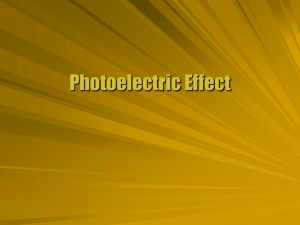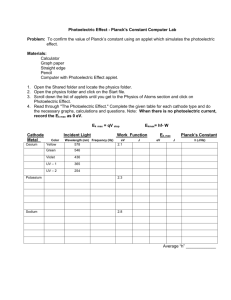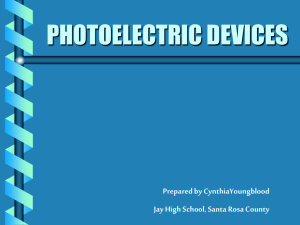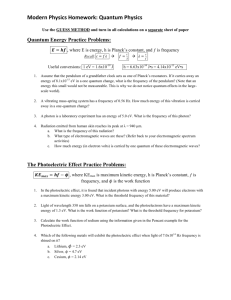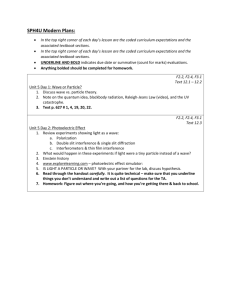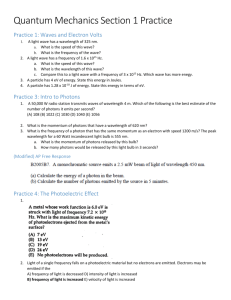Photoelectric Effect
advertisement
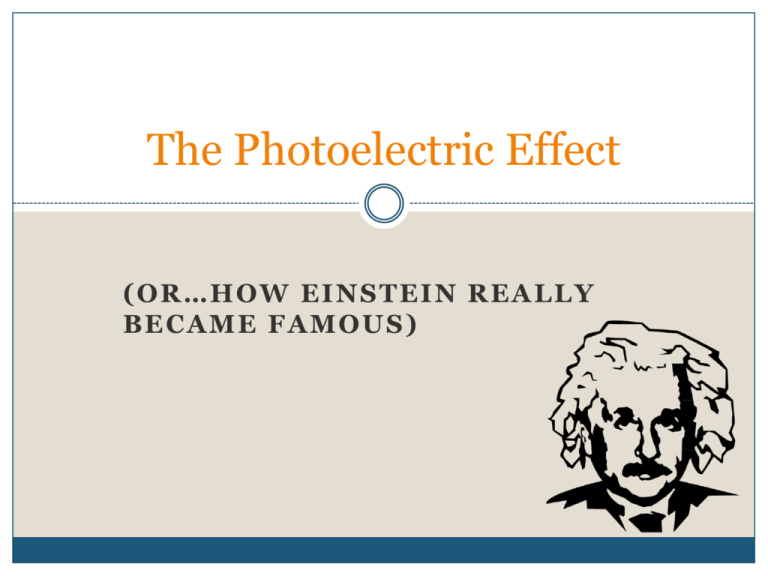
The Photoelectric Effect (OR…HOW EINSTEIN REALLY BECAME FAMOUS) Photo (light) + electric A photoelectric effect is any effect in which light energy is converted to electricity. First explained by Albert Einstein in 1905 When light strikes certain light-sensitive materials… It may cause them to give up electrons. Photoelectric Effect Metal Foil Photoelectric Effect Metal Foil Photoelectric Effect ►As blue light strikes the metal foil, the foil emits electrons. Photoelectric Effect Photoelectric Effect ►When red light hits the metal foil, the foil does not emit (give off) electrons. ►Blue light has more energy than red light. ►How could we get more energy into the red light? ►Try increasing the brightness (intensity). Photoelectric Effect Photoelectric Effect ►That didn’t work ►Maybe its still not bright (intense) enough. Photoelectric Effect Photoelectric Effect ►Still not working. ►What happens with brighter (more intense) blue light? Photoelectric Effect Photoelectric Effect ►More blue light means more electrons emitted, but that doesn’t work with red. Photoelectric Effect Photoelectric Effect High FREQUENCY light even from a dim source can eject electrons from a photosensitive metal Low Frequency light, even very bright (very intense) cannot dislodge electrons Photoelectric Effect ►Light, like all other radiation, is made up of small particles called photons. ►The higher the frequency, the more energy the photons have. ►Einstein stated that light interacts with matter as a stream of particle-like photons. ►Einstein received the Nobel Prize for this discovery. Einstein won the Nobel Prize for the Photoelectric Effect, not E= mc² Photoelectric Effect If a photon hits an atom of a certain material, it may be absorbed by an electron of that material. However, if the photon has enough energy, the electron is ejected, or emitted, from the atom. In this way, light energy changes into electrical energy. Photoelectric Effect If wires are attached to a photoemittive material, the electrons can flow along the wires, forming an electric current. WHY IS THE PHOTOELECTRIC EFFECT SO IMPORTANT? It helped explain the particle nature of light. It is the basis of the quantum theory. It is used in photocells e.g. in solar calculators, alarms, automatic garage door openers, flash of a camera Burglar Alarms When the light source to the semiconductor is interrupted by a person walking through the beam of light, a switch is activated that triggers the alarm. Review- Photoelectric Effect What it is : The ejection of electrons from certain metals when light falls upon them. The metals are said to be photosensitive (sensitive to light) Who and When: Einstein explained the photoelectric effect in 1905, but won the Nobel Prize in 1921


